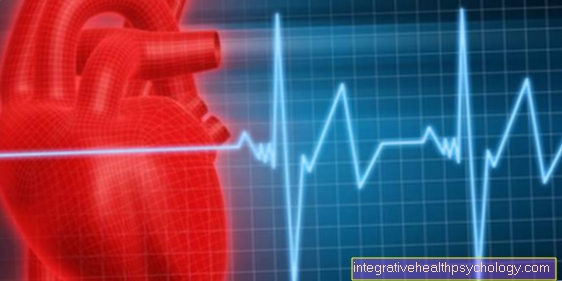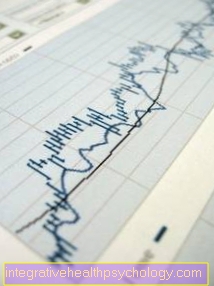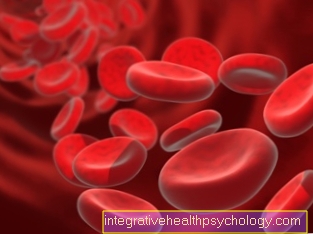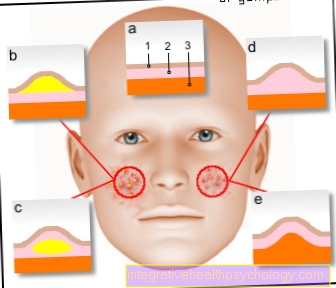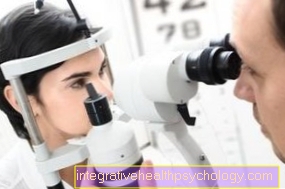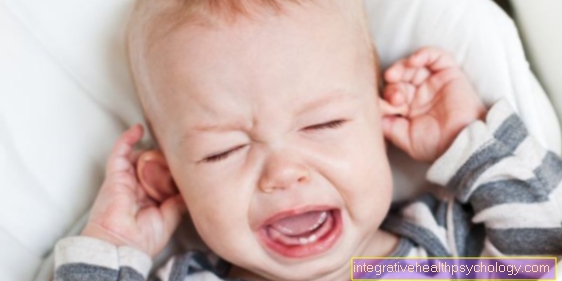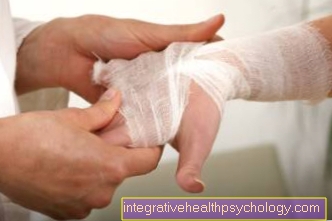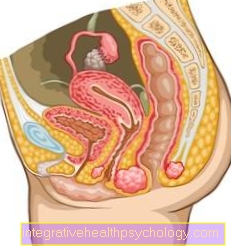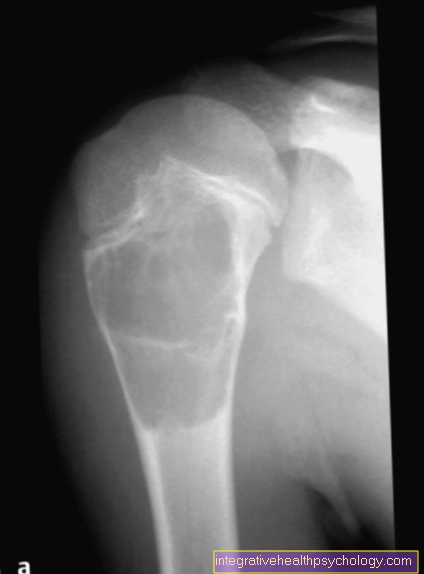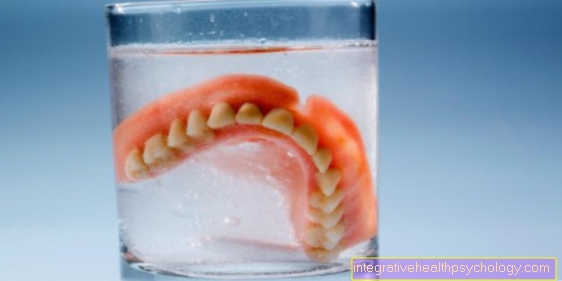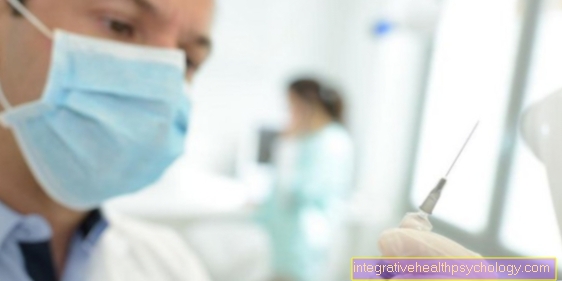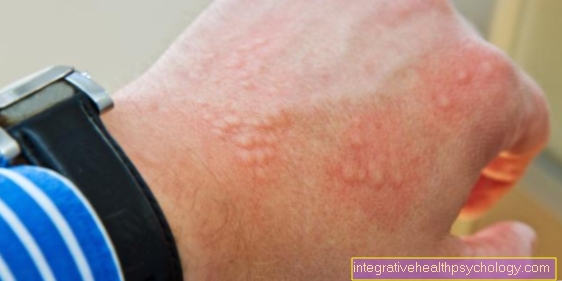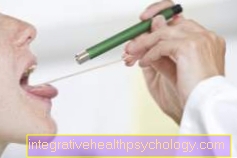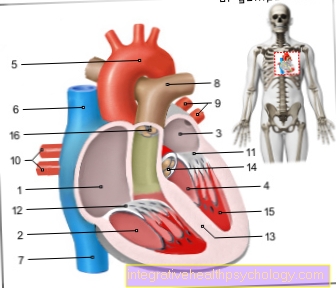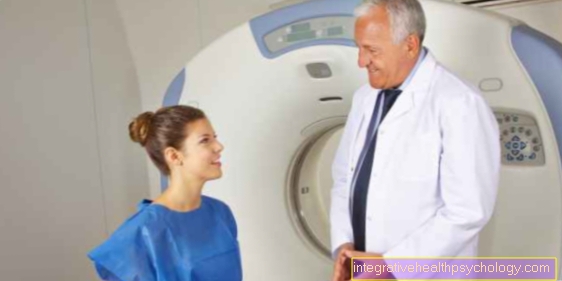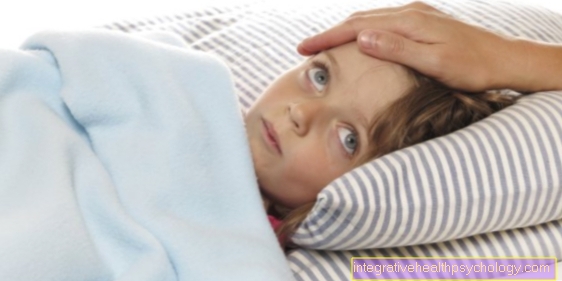Symptoms of low blood pressure
introduction
According to the medical definition, low blood pressure (hypotension) is present if it is below 100/60 mmHg. In Germany, around 2-4% of the population suffer from it, the majority of which are women.
Low blood pressure can have many different causes, which can be completely harmless in nature. However, it can also indicate organic or, in rare cases, dangerous diseases and should therefore be clarified if there are additional symptoms.
Blood is transported through the body by means of a heartbeat and supplies organs and tissues with nutrients and oxygen. How much and how quickly blood circulates through the body is determined in addition to the work of the heart, e.g. determined by blood pressure. Blood pressure is therefore an important factor in ensuring that nutrient-rich blood reaches the brain, for example.
If the blood pressure is only slightly lowered, it is not symptomatic in most of the people affected. However, if the pressure is too low, for example to transport the blood fast enough or in sufficient quantities into the tissue or organs, a wide range of noticeable symptoms can become noticeable.

What are the symptoms of low blood pressure?
If you have low blood pressure (arterial hypotension) the blood pressure is below the normal limit, i.e. it is lower than normal. This can result in very different symptoms, which can, but do not have to, occur individually for each individual. The following are the most common symptoms, from common to rare:
- Dizziness (often after getting up)
- Blackening of the eyes and flickering of the eyes
- See asterisks
- Fatigue and exhaustion
- cold hands and feet
- Headache or pressure
- Ringing in the ears and pressure
- Palpitations
- Listlessness
- insomnia
- Chest tightness
- Disturbances in consciousness leading to fainting
Dizziness from low blood pressure
Low blood pressure often leads to dizziness, which is often accompanied by “star vision”. Many of those affected also “black out” and they have the feeling of tipping over. Because not enough blood arrives in the brain and it is not adequately supplied for a very short time, dizziness can occur. Often times, dizziness can be felt when people with hypotension stand up. The blood sinks into the legs and cannot be pumped back to the heart and brain fast enough.
Especially in the morning before straightening up, people with low blood pressure should first sit on the edge of the bed. This can get the circulation going and prevent dizziness. Those affected often get dizzy if they have to stand for a long time.
Standing for long periods of time causes too much blood to remain in the legs. As a result, the brain cannot be adequately supplied and dizziness is triggered. People with low blood pressure also feel dizzy, especially in summer. Here the vessels in the brain are widened and the blood pressure drops even further, which in turn causes dizziness symptoms to occur more quickly.
Read more on this topic at: Dizziness from low blood pressure or Causes of dizziness
Fatigue from low blood pressure
Fatigue and fatigue can also be triggered by low blood pressure, especially if it lasts for a long time. As already explained in the section on dizziness, this leads to an insufficient supply (reduced perfusion) to the brain, as the low pressure cannot transport the blood sufficiently into the brain.
The tiredness is particularly noticeable during the summer with hot temperatures. When it is warm, the blood vessels expand physiologically to cool the body. However, the widening of the blood vessels also reduces the blood pressure even further and increases the anemia in the brain and causes fatigue, among other things.
Read more on this topic at: Chronic fatigue
Low blood pressure with a high pulse / racing heart
The pulse can be equated with the heartbeat. From a pulse that is too high (Tachycardia) is spoken when the heart beats more than 100 times a minute. This beating of the heart too fast can often be felt by those affected and is then called a racing heart.
Read more on this topic at: Causes of palpitations
The symptom combination of low blood pressure and high pulse can result, for example, from anemia. Anemia is most often caused by an iron deficiency, which is known as iron deficiency anemia.
The lack of blood can result in low blood pressure, with the risk that organs and tissues are no longer adequately supplied with oxygen. The heart tries to avert this undersupply and consequently beats with an increased beat frequency, which leads to a high pulse. Since the body generally tries to keep the circulation stable in spite of low blood pressure, other causes can cause a temporarily high pulse or a racing heart. If after long periods of sitting or standing the blood sinks into the veins of the legs, it can lead to so-called neurocardiogenic (vasovagal) syncope come. This leads to a brief loss of consciousness because the blood remaining in the legs lowers the cardiac output. This results in low blood pressure. In order to compensate for this, the pulse rises briefly.
In addition to blood deficiency and neurocardiogenic syncope, other causes such as an overdose of antihypertensive drugs, bleeding (for example in the gastrointestinal tract) or excessive fluid loss can lead to low blood pressure and, consequently, a high pulse.
For more helpful information, see: Low blood pressure and high pulse
Palpitations with low blood pressure
When the heart beats, the affected person feels his own heartbeat very clearly. The palpitations are a typical reaction to low blood pressure. It's an increased heart rate, so the heart beats faster. The pulse rises accordingly. The body tries to compensate for the lack of blood flow caused by the low blood pressure. So palpitations for this reason have nothing to do with stress or excitement. Affected people have palpitations even though they are in a normal or even relaxed and calm situation. An example of this is lying on the sofa. You can also get heart palpitations from low blood pressure when you get up from lying down or sitting up.
Palpitations with low blood pressure
The well-known stinging of the heart describes a sharp pain in the area of the chest, in close proximity to the heart. So it is a pain roughly at the level of the second to fifth rib behind the breastbone, which, however, can only be narrowed down by those affected. There may be a connection with low blood pressure, but it is not absolutely necessary. For this reason, the term "heart pounding" is very broad in colloquial language. The pain is usually sudden and very severe.The pain can come at different intervals. In addition, pain can be radiated into other parts of the body, such as a shoulder or arms. This should be observed carefully and reported to your doctor in order to rule out diseases such as a heart attack.
Low blood pressure with a low pulse
Many athletes have relatively low blood pressure and a slow pulse at rest. In most cases, this is an adjustment of the cardiovascular system and should not be a cause for concern. However, a low pulse and low blood pressure can also be caused by hormonal disorders. Above all, this includes hypothyroidism (Hypothyroidism), in which too few thyroid hormones T3 and T4 are produced. Since these hormones increase the heart rate and blood pressure, a deficiency can lead to them being too low.
Antihypertensive drugs such as beta-1 receptor blockers (e.g. metoprolol) can also lead to hypotension and bradycardia if overdosed or incorrectly used.
Please also read our article on this: Low blood pressure and pulse
Trembling from low blood pressure
Trembling is a typical symptom of low blood pressure. If there is sudden circulatory weakness that is triggered by low blood pressure, symptoms such as dizziness, nausea or sweating often also result in tremors in the extremities or the whole body. Here, too, the tremor is triggered by a temporary and short-term insufficient supply, which restricts brain function.
Read more on this topic at: Dizziness and tremors
Nausea from low blood pressure
Nausea is a typical symptom of low blood pressure. Above all, low blood pressure leads to nausea, if dizziness is present or has preceded it. If, for example, there is a circulatory disorder of the equilibrium organ due to low blood pressure, nausea and dizziness can suddenly occur. Low blood pressure-related nausea mostly occurs in the morning. This can also lead to dizziness. Particular care should be taken to ensure that a nutritious breakfast is eaten.
Patients affected by low blood pressure also often report that they do not have a proper appetite. The lack of food intake can increase nausea and dizziness. Since internal organs are not adequately supplied with blood due to the low blood pressure, they can no longer adequately fulfill their task. The same goes for the stomach. After eating, the food is difficult to digest and therefore often causes nausea, which in many cases can also be accompanied by vomiting.
Read more on this topic at:
- Dizziness with nausea
- Low Blood Pressure And Nausea - You Can Do That!
Headache with low blood pressure
Headaches are known to almost everyone. Due to the reduced blood flow to the brain, headaches are a symptom of low blood pressure. The pain can appear suddenly or gradually. In addition, it is possible that the headache is sharp, dull (similar to a migraine), pulling, pressing or pulsating. The pain intensity varies from barely noticeable to very severe.
Which area of the head is affected differs from person to person. The pain can be on the forehead, encompass the whole head, lie centrally, be placed on the temples, but also pull up from the neck into the head, often involving tense shoulder and neck muscles. They can occur regularly, but also irregularly. Head jokes can result in sensitivity to light and noise.
The pain is felt to be particularly severe when the person concerned does not drink enough fluids or the body is not supplied with sufficient oxygen.
Headache can also be caused by other causes besides low blood pressure. The range of variation in the causes of headaches is very large, so a doctor should be consulted if the pain persists. The exact description of the pain is important.
Read more on the subject at: Low blood pressure and headache
Migraines with low blood pressure
Migraine is a condition in which headache attacks occur periodically. An association with low blood pressure is likely, but migraines often occur independently. The migraine attacks can be very different. However, a rough distinction is made between different phases and their symptoms, which not everyone affected necessarily has. The heralding phase can last hours or up to two days. Even before the actual pain attack, one suffers from irritability, mood swings, tiredness or sensitivity to light and noise. This is followed by the typical headache, which can also last for hours, but oh days. The mostly severe headache occurs on one side or on the whole head. It is a pulsating pain that is particularly localized in the area of the temples, eyes and forehead. This is often accompanied by impaired perception, which can result in dizziness, impaired vision, speech disorders or disorientation. In addition, nausea and vomiting are often symptoms.
Tingling sensation from low blood pressure
Tingling is a term used to describe numbness. In addition to nerve disorders, these primarily indicate a lack of blood flow. The circulatory disorder can be caused by low blood pressure, which is perceived as tingling, especially in the hands and feet. This is due to the fact that, in comparison, the path of the oxygen-rich blood from the left heart to the feet or hands takes longer than to the nearby organs. Since the blood cannot be transported to the hands and / or feet quickly enough, circulatory disorders caused by low blood pressure are particularly noticeable there.
Difficulty breathing due to low blood pressure
If the low blood pressure is caused by a lack of blood (anemia), the anemia - especially when exerted - can also cause shortness of breath as a result. This is due to the fact that not enough oxygen can be transported due to, for example, a lack of erythrocytes, which can be particularly noticeable during exercise, where there is a higher consumption of oxygen, through shortness of breath. This is because the lungs can no longer be adequately supplied with oxygen.
Read more on this topic at: Difficulty breathing due to a weak heart
When do you faint?
Fainting means that you have no control over your consciousness for a brief moment (a few seconds), i.e. you are helplessly at the mercy of the situation. The risk of injury in the event of a fall is dangerous. In this case, the brain is no longer adequately supplied with blood because the blood pressure is too low. A circulatory disorder in the brain develops. Typically, fainting occurs due to a too fast change from lying or sitting to standing. So this has to be avoided. The blood sinks into the leg vessels and the brain is undersupplied with oxygen. Shortly before passing out, one is plagued by severe dizziness or sweating. If you notice this you should sit down or lie down immediately and get up very slowly and avoid hectic movements.
Symptoms around the eyes
Symptoms in the eyes that are triggered by hypotension are also caused by a short-term undersupply of the brain or eyes. This leads to blurred vision, "starry eyes" or "black eyes" for those affected. The symptoms in the eyes are usually accompanied by dizziness and often arise when getting up too quickly after sitting or lying down for a long time. If the symptoms also occur when moving, a doctor should be consulted in any case, as the symptoms in the eyes can have dangerous consequences, especially in traffic. If the eyes are not supplied for a longer period of time, the retina and optic nerve can also be damaged, which in the worst case can lead to blindness.
Fibrillation of the eyes with low blood pressure
The eye flicker (flickering scotoma) is a visual disorder in which an area of the field of vision is lost. This can occur on one or both sides. Often this imperceptible area is zigzag or star-shaped and surrounded by a light border. In addition, blurred light phenomena or flashes can occur when the eyes flicker. This is usually accompanied by a sensitivity to light. As a rule, the eye flickering lasts a few minutes and is different in severity in everyone. Eye flicker can be a symptom of low blood pressure.
See asterisks when your blood pressure is low
Seeing asterisks means that those affected see bright yellow to white flashes of light. The normal field of vision is therefore severely restricted. Seeing asterisks is often associated with dizziness and is a typical symptom of low blood pressure. This seeing lightning usually only lasts for a very short time. It occurs particularly frequently when the body changes quickly. This means that e.g. comes from lying to stand too quickly. The blood sinks in the legs, causing a lack of oxygen and blood deficiency in the brain. The eyes are also affected. The retina only works to a limited extent, which is why the flashes of light occur. Usually the symptoms don't last long, a few seconds at most. The blood circulation is quickly stimulated and the symptoms disappear completely.
"Black before eyes" with low blood pressure
The field of vision turns black after seeing flashes of light or stars and is a common symptom of low blood pressure. The field of vision is dark so that it can no longer be seen. This also happens when you quickly change your body position. Just like seeing asterisks, there is a lack of oxygen in the brain or in the retina. The photoreceptor cells temporarily stop working if the oxygen deficiency persists. This means that you can only see black. This condition is short-lived. If everything is supplied with normal blood again, you can quickly regain normal vision without restrictions.
Ringing in the ears due to low blood pressure
Ringing in the ears, as well as dizziness or visual disturbances, is usually caused by a reduced blood supply to the brain. It is expressed by a hissing noise or by a high-pitched whistle, as is also perceived in tinnitus. If the brain is not supplied with enough blood, the ringing in the ears is also often accompanied by symptoms such as dizziness or visual disturbances.
Read more on this topic at: Dizziness and blurred vision
Freezing from low blood pressure
The body surface is mainly warmed by increased blood flow. When the blood pressure is low, however, not enough blood reaches the surface in the small vessels. As a result, patients with low blood pressure have a reduced blood flow and therefore often an increased feeling of cold and freeze faster than other people. Because of this, most people have cold hands and feet, as it is the most difficult thing to use low pressure to get the blood to the ends of the arms and legs.
Ear pressure from low blood pressure
Ear pressure is a very unspecific symptom that is not necessarily associated with low blood pressure. The ear pressure can be described with the following symptoms, which are always differently pronounced. Starting with a harmless feeling of pressure, which can be compensated by swallowing (like in an elevator), to a strong and uncomfortable stabbing pain, dizziness, ringing in the ears, hearing noises in the ear, impaired hearing and ending with deafness. In addition, some people describe a feeling in the ear as if it was blocked. In summary, it can be said that everyone affected has an uncomfortable feeling in the ear when they suffer from ear pressure.
Sensation of pressure in the head with low blood pressure
Head pressure is usually understood to be a headache that is very pounding and pressing. One has the feeling that the brain is pressing against the skull. These headaches are often perceived by patients as dull, throbbing and bilateral, i.e. affecting the entire head. Often there are also side effects. These can take the form of nausea, vomiting, body aches and pains, and general malaise. This makes the patient's condition worse. A feeling of pressure in the head is very unspecific and not necessarily due to low blood pressure.
Potency disorders with low blood pressure
The erectile dysfunction, also called impotence, describes the man's inability to have sexual intercourse. The affected person is unable to get an erection for a long period of time (approx. 6 months) or to keep it long enough for successful sexual intercourse. This means that the male member does not stiffen properly, despite sexual arousal. Circulatory disorders can prevent an adequate erection. Blood pressure that is too low can also play a role. Blood flow is very important for erection because the stiffness of the penis is triggered by blood congestion. So it may be that too little blood flows into the male member.

